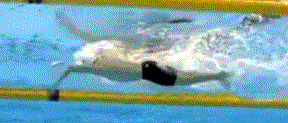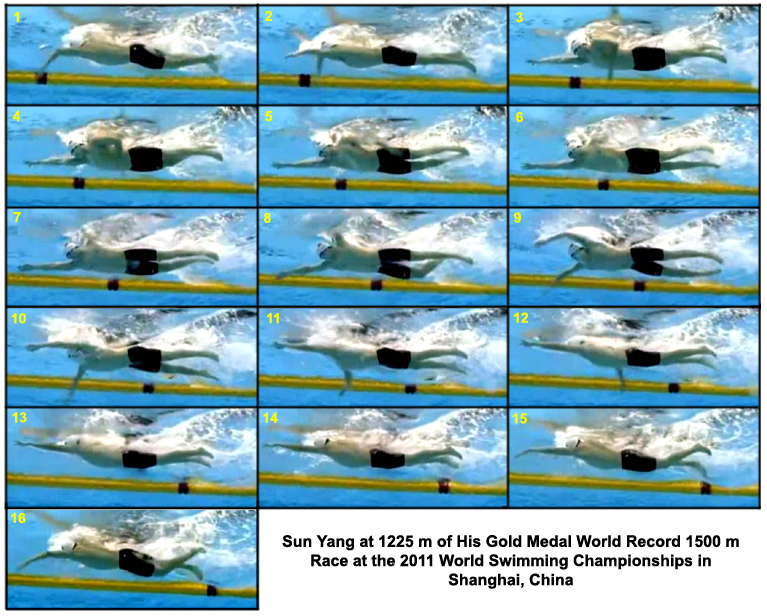HOW CHAMPIONS DO IT
Researched, produced, and prepared by Brent S. Rushall,
Ph.D., R.Psy.

SUN YANG AT 1,225 m OF HIS GOLD MEDAL WORLD RECORD 1,500 m RACE AT THE 2011 WORLD SWIMMING CHAMPIONSHIPS IN SHANGHAI, CHINA
This analysis is of the Chinese swimmer Sun Yang. In winning the 1,500 m race at the 2011 World Championships, he set a new world record of 14:34.14. The whole stroke cycle takes 1.7 seconds.
This stroke analysis includes a moving sequence in close to real time, a moving sequence where each frame is displayed for .5 of a second, and still frames.
The following image sequence is close to real time (each frame is approximately .1 seconds apart). It will play through 10 times and then stop. To repeat the sequence, click the browser's "refresh" or "reload" button.

The following image sequence shows each frame for half a second. It will play through 10 times and then stop. To repeat the sequence, click the browser's "refresh" or "reload" button.

At the end of the following narrative, each frame is illustrated in detail in a sequential collage.
Notable Features
- Frame #1: The right hand has just entered the water while the left arm begins to apply substantial force backward. The upper left arm abducts to provide the power for the pull. There is very marked overlap in this stroke causing the body to have only minimal, instead of substantial, rotation. That the upper right arm is aligned with the shoulders ensures that both internal and external rotator muscles in the shoulders provide the abductive force. However, in that position force will be applied outside the line of intended propulsion causing the swimmer to turn, a phenomenon that persists throughout the pull. The swimmer is almost streamlined with the thigh of the upper left leg adding to frontal resistance. The head could be lowered more which would facilitate better streamlining. The minor kicking action of the left leg occurs to counterbalance the vertical forces created by the entering right arm.
- Frame #2: The right arm has entered and created considerable drag resistance. The direction of the milky turbulence off the arm indicates the direction of the resistive force. Abduction of the upper left arm continues with the hand-forearm surface providing most of the propulsive force. The left leg has completed its kick with the toes pointed down and back. This also produces a resistive force as is demonstrated by the milky turbulence off the foot that is directed almost straight back. This dragging foot could possibly serve a steering function to counteract the forces created by the left arm which are wide of the centerline of the swimmer's progression. The head being angled forward causes the chest to drop down, which in turn creates a greater cross-sectional area of the swimmer's profile. The top of the buttocks being obviously lower than the head, signals a less than desirable alignment of the body segments which creates added turbulence. That turbulence is signaled by the massive and deep white turbulence following on top of and behind the swimmer's torso.
- Frame #3: The right arm is stretched fully forward and "parked". The left arm continues propulsion by changing from abduction to adduction with the forearm-hand still being at right angles to the direction of movement. That position maximizes the drag force propulsion off that portion of the propelling arm. The swimmers eyes still look forward and down. The curvature of the upper torso, neck, and face illustrates exaggerated frontal resistance. The feet have risen during the no-kick phase of the two-beat kick employed by the swimmer. As happens with two-beat kicking, the angles of the ankles change occasionally to produce counter-balancing forces to produce slight modifications in the swimmer's alignment. In doing that, they act somewhat like trim-tabs on an airplane wing.
- Frame #4: The right arm remains parked in front of the swimmer. In that position, the surface resistance of the swimmer is increased. As well, the arm produces some detrimental drag resistance as evidenced by the white water turbulence on the top of the arm. The head still looks forward causing a curved swimmer alignment rather than one that is straight/flat. The left arm begins to exit by lifting the elbow. In this instance, a desirable feature of a crawl stroke finish is exhibited. That is, when the arm is fully adducted and the forearm-hand is vertical, extraction should occur. Further movement of the hand backward through elbow extension would result in rapid diminution of the propulsive surface and its 90 degree "angle of attack", increased resistance, and overall loss of propulsive force.
- Frame #5: The right arm continues to be parked in front of the swimmer and continues to generate unwanted resistance. The head continues to look forward and slightly down. The left arm has almost exited. The arm at exit is bent, close to the 90 degrees illustrated in the previous frame. Both feet trail high. There is no propulsion developed in this frame; the swimmer slows.
- Frame #6: The right arm continues to be parked in front of the swimmer. The left arm recovers. The head continues to look forward and slightly down. The torso has flattened slightly more than exhibited in the previous frames. The feet move slightly and assumedly in a "trim-tab" role. There is no propulsion in this frame; the swimmer slows.
- Frame #7: The same characteristics of the previous frame are replicated. There is no propulsion in this frame; the swimmer slows.
- Frame #8: The right arm begins to sink and bend at the elbow. The left arm begins to approach the water developing a vertical force. The right leg bends and starts to kick to counter-balance the recovering left arm. The kick might have a short-lived horizontal force component but has a much larger vertical force. Potential propulsive forces developed at this stage of the stroke are minor and would add little to alter the deceleration of the swimmer. The deceleration of the swimmer who has executed a classic overtaking stroke has lasted for at least .3 of a second.
- Frame #9. The right arm is very likely to be propulsive at this stage. Visual distortion is created by the angle at which these images were captured. The right arm movements actually are very similar to those of the left arm and described in the earlier frames. The left leg is close to completing its counter-balancing function for the right arm. The left arm has entered and created considerable drag resistance.
- Frame #10: The right arm pulls with a close to vertical orientation to the line of intended propulsion. The left arm remains parked in front of the swimmer and creates considerable drag resistance. The right leg completes its kick. The swimmer appears to be more streamlined in this phase of the stroke than when the left arm was pulling. The head begins to rise causing the appendages of the face to develop drag resistance.
- Frame #11: The right arm is being adducted and the forearm-hand enters the final stage of propulsion. The left arm extends further forward suggesting that there is some downward pressure on the arm so that it performs a minor support function. The support could be for a raising and turning of the head (which is evident in the next several frames).
- Frame #12: The right arm is positioned to exit. The forearm-hand surface is still pushing backward but is sliding upward at the same time as the elbow begins to rise to exit. The head position and the way it causes the upper torso to be curved and pronounce the cross-sectional resistance of the swimmer is once again displayed in the frame. The feet rise.
- Frame #13: The right arm is close to exiting with only the hand and wrist in the water. The left arm is extended. Part of the head is above the water surface. The legs rise but the feet are in a "drag" position causing an undue but possibly necessary rise in resistance. Propulsion has been completed and the swimmer slows.
- Frame #14: The right arm recovers. The left arm continues to be parked in front of the swimmer. The legs rise with an increase in the drag position of the feet. There is no propulsion in this frame; the swimmer slows.
- Frame #15: The right arm recovers. The left arm begins to be repositioned for propulsion. The wrist begins to bend at the same time the elbow flexes and upper arm medially rotates (the action that is necessary to achieve the position exhibited in Frame #1. The feet are in most ungainly positions causing considerable drag and no hint of propulsion. The head is still high. In relation to the lane rope, the forward half of the swimmer is not streamlined. There is no propulsion in this frame; the swimmer slows.
- Frame #16: The right arm approaches entry. The left arm flexes at the elbow and the upper arm continues to medially rotate. It is possible that a sufficient horizontal force component is developed at this time to stop any further slowing. The left leg rises preparatory to kicking as a counter-balancing movement for the soon to enter right arm. That exaggerated kick disrupts streamlining further as the knee drops outside of the cross-sectional area of the forward part of the swimmer. The next stroke phase is illustrated in Frame #1. While the left arm is parked in front, the length of time that the swimmer is not in propulsion and over which slowing occurs is approximately .3 seconds.
Much could be done with streamlining in this swimmer. The head could be pushed lower in the water with possibly the eyes looking directly at the bottom of the pool. That reorientation would cause the hips to rise and the torso to flatten. Both are features of improved streamlining.
Recovering over the water rather than entering as early as demonstrated with both arms would also reduce drag resistance created on and after entry.
Sun Yang swam the majority of the first 1,400 meters of the race with a two-beat kick or a three-beat kick depending on the definition of a kick. Over that distance he was behind record pace. For the last 100 meters he employed a very fast moderate size six-beat kick and blistered home in 54.22 with the last 50 meters in 25.94.
The pitfalls of an overtaking stroke are clearly shown in this swimmer. The inertial lag after the left arm pull is slightly longer than that after the right arm. Approximately six of the sixteen frames in this stroke do not demonstrate propulsion. That equates to ~38% of this stroke not being in propulsion, a state where the swimmer slows. Improvements should be expected if propulsion becomes more dominant and inertial lags are reduced or eliminated. That should result in closer compliance with Newton's First Law and a state where energy expenditure is more efficient.
Overtaking strokes are relatively common in male distance freestylers. The inherent errors of motion and undesirable limitations of that stroking format could be argued as being the principal reason why the men's 1,500 m race has improved the least of all swimming races and strokes over the past decade (even despite the introduction of the performance-enhancing super suits). Grant Hackett's world record set in Fukuoka in 2001 was 14:34.56. In this race, Sun Yang improved that record by .42 seconds. Until overtaking and uneven stroking characteristics are removed from men's distance-freestyle, the record will remain quite stagnant. Given the usual growth characteristics/curves of world records, to which the men's 1,500 m does not comply, the record for this event would seem to be potentially the easiest to break and the amount of improvement should be very substantial.

Return to Table of Contents for this section.

![]()



![]()